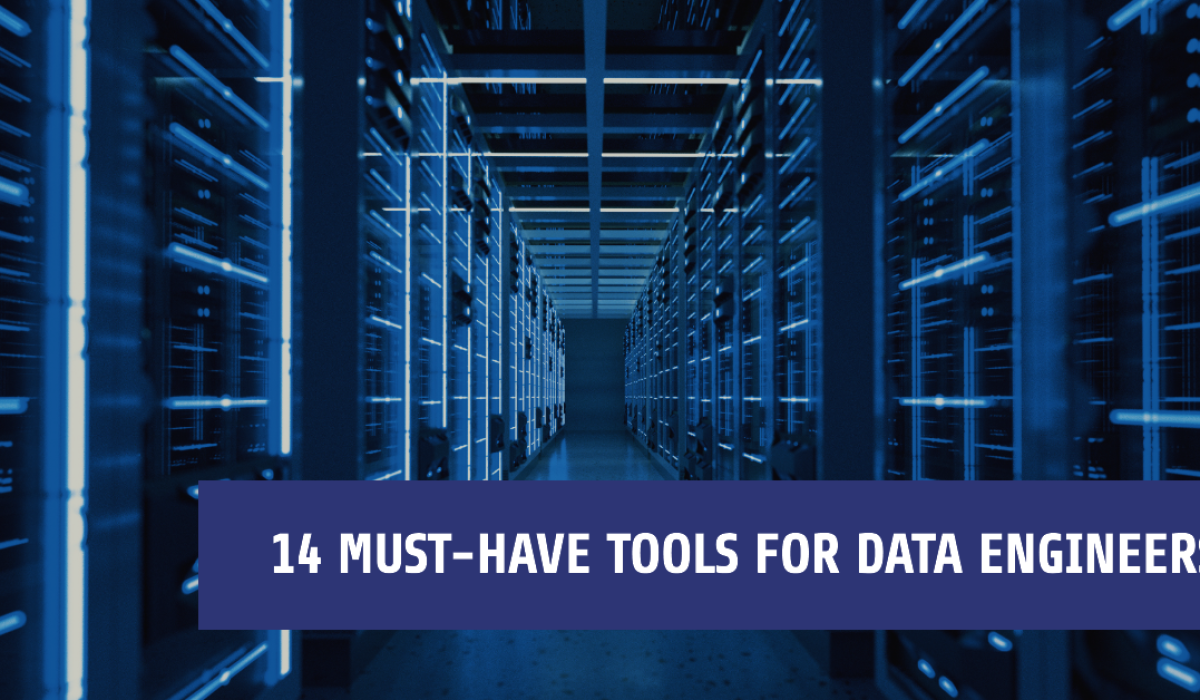
In today’s data-driven world, efficient data pipelines are the backbone of powerful analytics and applications. Data engineers are the architects of these pipelines, and the right tools are essential for building them effectively.
This article explores the essential toolkit for data engineers in 2024. We’ll delve into various categories of tools that empower data engineers to streamline data ingestion, processing, storage, and ultimately, deliver high-quality data for valuable insights.
The categories we’ll cover include:
- Infrastructure Management: Tools for managing and provisioning infrastructure, both on-premise and in the cloud.
- Workflow Orchestration: Tools for automating and scheduling data pipeline tasks.
- Data Warehousing: Tools for storing and managing large datasets for efficient analysis.
- Analytics Engineering: Tools for transforming and preparing data for consumption by analysts and data scientists.
- Batch Processing: Tools for handling large datasets in a batched manner.
- Streaming Processing: Tools for processing data in real-time as it’s generated.
Containerization Tools
Building Blocks for Scalable Pipelines: Containerization
Before diving into specific tools, let’s explore a fundamental concept in modern data engineering: containerization.
Containerization is a virtualization technique that packages an application with all its dependencies (libraries, configuration files) into a lightweight, portable unit called a container. Imagine a container as a standardized shipping box for your application. This box ensures your application runs consistently across different environments, regardless of the underlying operating system.
There are two key players in the containerization world:
- Docker: Docker is a leading platform for building, sharing, and running containers. It allows data engineers to easily create container images, which are essentially blueprints for containers. These images can then be deployed and run on any machine with Docker installed. Docker simplifies the process of managing application lifecycles within containers.
- Kubernetes: While Docker excels at managing individual containers, Kubernetes goes a step further. It’s an orchestration platform that automates the deployment, scaling, and management of containerized applications. Think of Kubernetes as an entire container shipping yard. It manages the deployment of multiple containers, ensures they run smoothly together, and automatically scales resources based on demand.
Infrastructure as Code (IaC) Tools
Automating Infrastructure with IaC
Now that we’ve explored containerization, let’s shift our focus to managing the infrastructure that runs our data pipelines. This is where Infrastructure as Code (IaC) comes in.
IaC is a practice of managing and provisioning infrastructure through machine-readable configuration files. Instead of manually configuring servers, storage, and networking components, data engineers define the desired infrastructure state in code. This code can then be used to automatically create and manage the infrastructure across different environments.
Here’s why IaC is essential for data engineers:
- Repeatability and Consistency: IaC ensures that infrastructure is provisioned consistently across environments, reducing errors and configuration drift.
- Automation: IaC automates tedious manual tasks, freeing up data engineers to focus on higher-level activities.
- Version Control: IaC configurations can be stored in version control systems like Git, allowing for tracking changes and rollbacks if necessary.
There are several IaC tools available, but two leading contenders are:
- Terraform: Terraform is a popular open-source IaC tool that supports a wide variety of cloud providers and infrastructure platforms. It uses a declarative language where you define the desired state of your infrastructure, and Terraform takes care of provisioning the resources.
- Pulumi: Pulumi is another powerful IaC tool that offers a unique approach. It allows data engineers to write IaC configurations using familiar programming languages like Python or Javascript. This can make IaC more accessible to developers with existing programming skills.
Workflow Orchestration Tools
Coordinating the Flow: Workflow Orchestration
Data pipelines are rarely linear processes. They often involve multiple steps, such as ingesting data from various sources, transforming the data, and loading it into a data warehouse. Here’s where workflow orchestration tools come into play.
The Role of Workflow Orchestration
Workflow orchestration tools automate the scheduling, execution, and monitoring of tasks within a data pipeline. They act as the conductor of an orchestra, ensuring each component plays its part at the right time and in the correct order.
Here’s how workflow orchestration benefits data engineers:
- Automation: Orchestration eliminates the need for manual scheduling and execution of pipeline tasks, saving time and reducing human error.
- Visibility and Monitoring: These tools provide real-time insights into the health of your pipeline, allowing you to identify and troubleshoot issues quickly.
- Scalability: They enable you to easily scale your pipelines by adding or removing tasks as needed.
Must-Have Tools for Workflow Management
Several robust workflow orchestration tools are available, but let’s look at two popular options:
- Prefect: Prefect is a Python-based workflow management solution that offers a user-friendly interface for building and managing data pipelines. It allows data engineers to easily define dependencies between tasks and schedule them for execution. Prefect also provides robust monitoring and logging capabilities, enabling you to track the progress of your pipelines and identify any issues.
- Luigi: Luigi is another popular open-source workflow management tool written in Python. It emphasizes code-driven workflows, where tasks are defined as Python classes. Luigi offers features like dependency management, retries, and email notifications on failures.
Analytics Engineering Tools
Building Bridges for Data Consumers: Analytics Engineering
Now that we’ve covered data storage and orchestration, let’s delve into a crucial aspect of the data journey: analytics engineering.
What is Analytics Engineering?
Analytics engineering focuses on building, maintaining, and evolving the infrastructure that transforms raw data into a consumable format for data analysts and scientists. Essentially, analytics engineers bridge the gap between raw data and actionable insights.
Their work involves tasks like:
- Data Transformation: Transforming raw data into a clean, consistent, and usable format for analysis.
- Data Modeling: Designing data models that optimize query performance and facilitate exploration.
- Documentation and Testing: Ensuring data pipelines are well-documented and tested for quality and reliability.
Empowering Analytics Engineers with the Right Tools
Several tools empower data engineers to excel in their roles. Here, we’ll explore two prominent choices:
- dbt (data build tool): dbt is an open-source framework specifically designed for data transformation in data warehouses. It allows data engineers to write SQL code in a modular and reusable way, improving data quality and reducing maintenance overhead. dbt also integrates seamlessly with various data warehouses, simplifying the transformation process.
- Metabase: Metabase is an open-source business intelligence (BI) tool that empowers data analysts and non-technical users to explore and visualize data stored in the data warehouse. Analytics engineers can leverage Metabase to define metrics and dimensions within the data warehouse, making it easier for business users to ask and answer questions of the data.
Batch Processing Tools
Tackling Big Data Efficiently: Batch Processing
Data pipelines often handle massive datasets that can overwhelm traditional processing methods. This is where batch processing comes in.
Batch Processing Explained
Batch processing involves grouping data into sets or batches and processing them collectively. It’s a cost-effective way to handle large volumes of data, leveraging economies of scale. Think of it as processing a large stack of documents in groups, rather than one by one.
Here are some key benefits of batch processing:
- Efficiency: Processing data in batches leverages system resources more efficiently, leading to faster processing times compared to individual data points.
- Cost-Effectiveness: Batch processing can be scheduled for off-peak hours when computing resources are less expensive.
- Reliability: Batch processing often includes error handling and retry mechanisms to ensure data integrity.
Leading Batch Processing Frameworks
Several powerful tools facilitate batch processing in data engineering. Here, we’ll explore two prominent frameworks:
- Apache Spark: Spark is a unified analytics engine that excels in both batch processing and real-time data processing (streaming). It offers a high-level API (Application Programming Interface) that simplifies writing distributed applications for large-scale data processing. Spark leverages in-memory processing for faster performance, making it ideal for complex data transformations on big data.
- Apache Hadoop: Hadoop is a foundational open-source framework for distributed processing of large datasets across clusters of computers. It offers a distributed file system (HDFS) for storing data and a processing engine (YARN) to run tasks in parallel. Hadoop is particularly well-suited for batch processing large datasets that don’t require real-time analysis.
Section 7: Streaming Processing Tools
The Power of Now: Real-time Analytics with Streaming
While batch processing excels at handling large datasets, the world generates data constantly. For scenarios requiring real-time insights, data streaming becomes essential.
Why Stream Processing Matters
Data streaming involves processing data as it’s generated, enabling real-time analysis and decision making. This is crucial in various applications, such as:
- Fraud Detection: Analyzing financial transactions in real-time to identify and prevent fraudulent activity.
- Sensor Data Analysis: Gaining real-time insights from sensor data in areas like IoT (Internet of Things) or industrial automation.
- Personalized Recommendations: Recommending products or content to users based on their real-time behavior.
Enabling Real-time Analytics with Streaming Platforms
Building real-time data pipelines requires robust streaming platforms. Here, we’ll explore two popular options:
- Apache Kafka: Kafka is a distributed streaming platform that acts as a central hub for ingesting and distributing real-time data streams. It allows you to publish data streams (topics) and subscribe to them from various applications for processing. Kafka is known for its scalability, fault tolerance, and high throughput, making it a reliable foundation for real-time data pipelines.
- Apache Flink: Flink is a stateful stream processing engine that analyzes data streams in real-time. It allows you to write applications that process and transform data streams with low latency. Flink integrates seamlessly with Kafka, enabling you to ingest data from Kafka and perform real-time analytics on the data stream.
Building Your Data Engineering Toolkit for Success
The data engineers play a pivotal role in building the pipelines that deliver valuable insights. This article explored a comprehensive toolkit for data engineers in 2024, encompassing various categories:
- Infrastructure Management: Containerization tools like Docker and Kubernetes streamline containerized application deployment and management. IaC tools like Terraform and Pulumi automate infrastructure provisioning for consistent and scalable environments.
- Workflow Orchestration: Prefect and Luigi orchestrate data pipeline tasks, ensuring smooth execution, monitoring, and scheduling.
- Data Warehousing: Snowflake and PostgreSQL offer efficient data storage and organization for historical analysis.
- Analytics Engineering: dbt facilitates data transformation in data warehouses, while Metabase empowers data exploration for analysts and business users.
- Batch Processing: Apache Spark and Apache Hadoop excel at handling large datasets efficiently in batch jobs.
- Streaming Processing: Apache Kafka acts as a central hub for ingesting and distributing real-time data streams, while Apache Flink enables real-time analytics on those streams.
This diverse set of tools empowers data engineers to build robust, scalable, and efficient data pipelines. Whether your focus is on batch processing massive datasets, enabling real-time analytics, or streamlining data delivery for analysis, the tools explored in this article offer solutions.





